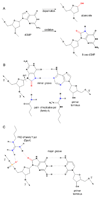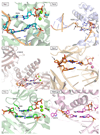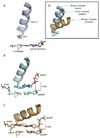DNA polymerases provide a canon of strategies for translesion synthesis past oxidatively generated lesions
- PMID: 21482102
- PMCID: PMC3112272
- DOI: 10.1016/j.sbi.2011.03.008
DNA polymerases provide a canon of strategies for translesion synthesis past oxidatively generated lesions
Abstract
Deducing the structure of the DNA double helix in 1953 implied the mode of its replication: Watson-Crick (WC) base pairing might instruct an enzyme, now known as the DNA polymerase, during the synthesis of a daughter stand complementary to a single strand of the parental double helix. What has become increasingly clear in the last 60 years, however, is that adducted and oxidatively generated DNA bases are ubiquitous in physiological DNA, and all organisms conserve multiple DNA polymerases specialized for DNA synthesis opposite these damaged templates. Here, we review recent crystal structures depicting replicative and bypass DNA polymerases encountering two typical lesions arising from the oxidation of DNA: abasic sites, which block the replication fork, and the miscoding premutagenic lesion 7,8-dihydro-8-oxoguanine (8-oxoG).
Copyright © 2011 Elsevier Ltd. All rights reserved.
Figures




Similar articles
-
Mechanism of efficient and accurate nucleotide incorporation opposite 7,8-dihydro-8-oxoguanine by Saccharomyces cerevisiae DNA polymerase eta.Mol Cell Biol. 2005 Mar;25(6):2169-76. doi: 10.1128/MCB.25.6.2169-2176.2005. Mol Cell Biol. 2005. PMID: 15743815 Free PMC article.
-
Kinetic basis for the differing response to an oxidative lesion by a replicative and a lesion bypass DNA polymerase from Sulfolobus solfataricus.Biochemistry. 2012 Apr 24;51(16):3485-96. doi: 10.1021/bi300246r. Epub 2012 Apr 10. Biochemistry. 2012. PMID: 22471521
-
Evading the proofreading machinery of a replicative DNA polymerase: induction of a mutation by an environmental carcinogen.J Mol Biol. 2001 Jun 1;309(2):519-36. doi: 10.1006/jmbi.2001.4674. J Mol Biol. 2001. PMID: 11371169
-
Structure of human DNA polymerase iota and the mechanism of DNA synthesis.Biochemistry (Mosc). 2012 Jun;77(6):547-61. doi: 10.1134/S0006297912060016. Biochemistry (Mosc). 2012. PMID: 22817454 Review.
-
Translesion DNA synthesis: polymerase response to altered nucleotides.Cancer Surv. 1985;4(3):493-516. Cancer Surv. 1985. PMID: 2825983 Review.
Cited by
-
Contribution of partial charge interactions and base stacking to the efficiency of primer extension at and beyond abasic sites in DNA.Biochemistry. 2012 Jun 19;51(24):4922-31. doi: 10.1021/bi300296q. Epub 2012 Jun 7. Biochemistry. 2012. PMID: 22630605 Free PMC article.
-
Mycobacterium smegmatis DinB2 misincorporates deoxyribonucleotides and ribonucleotides during templated synthesis and lesion bypass.Nucleic Acids Res. 2014 Nov 10;42(20):12722-34. doi: 10.1093/nar/gku1027. Epub 2014 Oct 28. Nucleic Acids Res. 2014. PMID: 25352547 Free PMC article.
-
Development of a 'clickable' non-natural nucleotide to visualize the replication of non-instructional DNA lesions.Nucleic Acids Res. 2012 Mar;40(5):2357-67. doi: 10.1093/nar/gkr980. Epub 2011 Nov 15. Nucleic Acids Res. 2012. PMID: 22086959 Free PMC article.
-
Kinetic mechanism and fidelity of nick sealing by Escherichia coli NAD+-dependent DNA ligase (LigA).Nucleic Acids Res. 2016 Mar 18;44(5):2298-309. doi: 10.1093/nar/gkw049. Epub 2016 Feb 8. Nucleic Acids Res. 2016. PMID: 26857547 Free PMC article.
-
The miscoding potential of 5-hydroxycytosine arises due to template instability in the replicative polymerase active site.Biochemistry. 2011 Nov 29;50(47):10350-8. doi: 10.1021/bi201219s. Epub 2011 Nov 3. Biochemistry. 2011. PMID: 22026756 Free PMC article.
References
-
-
Loeb LA, Monnat RJ., Jr DNA polymerases and human disease. Nat Rev Genet. 2008;9:594–604. • This well-executed and thorough review describes the polymerases of the human genome inclusively, presenting some compelling figures to accompany the discussion.
-
-
- Bebenek K, Kunkel TA. Functions of DNA polymerases. Adv Protein Chem. 2004;69:137–165. - PubMed
-
- Lovett ST. Polymerase switching in DNA replication. Mol Cell. 2007;27:523–526. - PubMed
Publication types
MeSH terms
Substances
Grants and funding
LinkOut - more resources
Full Text Sources
Other Literature Sources
Miscellaneous

